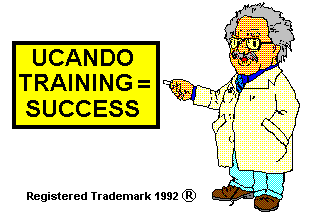
UCANDO VCR Educational Products Co.
We Now Only Accept Checks or Money Orders
Prices are US Currency, and donot include shipping and handling.
Training Modules are $12.00 for one then $4.00, for any others
California residents, add 7.25% State Tax.
Send checks or Money orders to
Alex Electronics
597 Circlewood Dr.
Paradise, CA. 95969
Call 530-872-0896 for Information..
Or email to frank597@comcast.net
Most All Training Videos come complete with a question/
answer book designed to give you the most from your training.
Troubleshooting Hydraulic Systems
Retail cost $ 215.00 Your cost $ 186.00
The "HYD" training program provides an intensive 32 hours of fluid dynamic
principles designed to teach your students, or employees how to understand
and troubleshoot hydraulic system failures. All maintenance repair persons
should know and understand hydraulic fundamentals and circuit operation.
Understanding hydraulic system operation is mandatory for all industrial
maintenance technicians. This training is vital for the efficient repair
of any electric over hydraulic machinery. Your people need this training
if your facility has machinery utilizing hydraulic components. Suggested
training time with final exam is 36 hours.
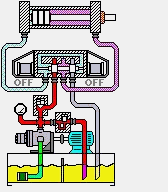 HYD Training Part 1:
Training segment 1 begins with the basics of fluid dynamics. Your students,
or employees will learn how power can be transmitted through fluid. Part 1
then continues into an examination of 2 way valves, 3 way valves, check
valves and pressure relief valves. They will see how these devices actually
function and how they are implemented in an actual circuit design. Prior
experience or training is not a requirement for this training program.
However, those with prior experience or training will gain a deeper
understanding of hydraulic system operation.
HYD Training Part 2: In part 2, your employees or students will examine linear and rotary
actuators. Double action, double rod, ram, telescoping, tandem and duplex cylinder operations are
all covered in this easy to learn training video. Rotary devices like rack-and-pinion, rotary vane
and rotary cylinder actuators are also illustrated in detail. In four short hours your students
will learn more than most people learn in a week.
HYD Training Part 3: In the third training session your employees, or students will examine
common hydraulic pumps like the balanced vane, unbalanced vane, gear, axial piston and radial piston
hydraulic pump configurations. Part 3 also covers different types of filters and the purpose for
using a reservoir.
HYD Training Part 4: Part 4 provides an in depth examination of hydraulic motors, accumulators
and intensifiers. Your students, or employees will learn the differences between spring loaded, various
gas charged and weight loaded accumulator devices. Safety dump circuits for the accumulator are also
covered in this portion of your hydraulic training.
HYD Training Part 5: During this training session your employees, or students will examine flow
control and pressure sensitive devices in greater detail. They will also learn about air cooled and
water cooled heat exchangers. Testing the heat exchanger for internal leaks is also covered in part 5.
HYD Training Part 1:
Training segment 1 begins with the basics of fluid dynamics. Your students,
or employees will learn how power can be transmitted through fluid. Part 1
then continues into an examination of 2 way valves, 3 way valves, check
valves and pressure relief valves. They will see how these devices actually
function and how they are implemented in an actual circuit design. Prior
experience or training is not a requirement for this training program.
However, those with prior experience or training will gain a deeper
understanding of hydraulic system operation.
HYD Training Part 2: In part 2, your employees or students will examine linear and rotary
actuators. Double action, double rod, ram, telescoping, tandem and duplex cylinder operations are
all covered in this easy to learn training video. Rotary devices like rack-and-pinion, rotary vane
and rotary cylinder actuators are also illustrated in detail. In four short hours your students
will learn more than most people learn in a week.
HYD Training Part 3: In the third training session your employees, or students will examine
common hydraulic pumps like the balanced vane, unbalanced vane, gear, axial piston and radial piston
hydraulic pump configurations. Part 3 also covers different types of filters and the purpose for
using a reservoir.
HYD Training Part 4: Part 4 provides an in depth examination of hydraulic motors, accumulators
and intensifiers. Your students, or employees will learn the differences between spring loaded, various
gas charged and weight loaded accumulator devices. Safety dump circuits for the accumulator are also
covered in this portion of your hydraulic training.
HYD Training Part 5: During this training session your employees, or students will examine flow
control and pressure sensitive devices in greater detail. They will also learn about air cooled and
water cooled heat exchangers. Testing the heat exchanger for internal leaks is also covered in part 5.
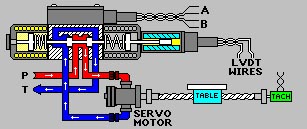
HYD Training Part 6: Part 6 concentrates on hydraulic servo
valve operation. Single spool, master-slave and proportional valves
are all covered in this training segment. The purpose of the LVDT is
also discussed in part 6. This training segment provides a very good
understanding of hydraulic servo valve operation.
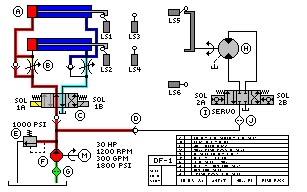 HYD Training Part 7: Training session 7 begins to apply all the
knowledge your employees, or students have gained in the first 6 training
sessions by illustrating hydraulic prints with the valves shifting position,
cylinders extending and retracting, pressure relief valves operating, flow
controls restricting flow and check valves opening and closing under pressure.
Learning to read a hydraulic print has never been easier.
HYD Training Part 8: The final training session covers basic hydraulic troubleshooting techniques,
fault analysis, common hydraulic system failures and preventative maintenance procedures which can
be implemented to extent the life of almost any piece of hydraulic equipment.
Table Of Contents
HYD Training Part 7: Training session 7 begins to apply all the
knowledge your employees, or students have gained in the first 6 training
sessions by illustrating hydraulic prints with the valves shifting position,
cylinders extending and retracting, pressure relief valves operating, flow
controls restricting flow and check valves opening and closing under pressure.
Learning to read a hydraulic print has never been easier.
HYD Training Part 8: The final training session covers basic hydraulic troubleshooting techniques,
fault analysis, common hydraulic system failures and preventative maintenance procedures which can
be implemented to extent the life of almost any piece of hydraulic equipment.
Table Of Contents
Troubleshooting PLC Systems
Retail cost $ 215.00 Your cost $ 186.00
The "PLC" training program is an intensive 8-part training course that will
meet or exceed your PLC training needs. Within one short week, this amazing
training program will have your students, or employees reading, understanding
and troubleshooting Programmable Logic Control systems.
The easy to follow lesson format allows each person to learn at an accelerated
rate. The information gained from each lesson can be used immediately by those
participating in this training exercise. Both rung and block format PLC
instructions are covered in this complete training package. Suggested training
time with final exam is 36 hours. A solid understanding of relay circuitry is
recommended before presenting this training program.
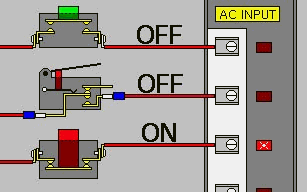 PLC Training Part 1: The PLC training program begins by comparing
the operation of relay circuitry to that of the PLC system. Understanding
these similarities will make learning the PLC system much faster and easier.
The student will learn the sequence of events which must take place in any
automated piece of equipment. They are also introduced to the three
sections of every PLC control system.
PLC Training Part 2: In part 2 of the PLC program your students will be introduced to the operating
principles involved with the input, output and logic sections of the PLC system. Then they will begin their
understanding of basic PLC logic instructions. They will learn about the examine ON, examine OFF and output
instruction bits. Next, they will begin to apply these PLC instruction bits to actual PLC ladder diagrams.
Common addressing techniques are also covered in part 2.
PLC Training Part 3: In the third training session your students will gain an in depth understanding
of the operating principles involved with the input, output and logic sections of the PLC system. Analog,
digital and discrete modules are covered. Part 3 also provides vital information on common power
supply problems.
PLC Training Part 1: The PLC training program begins by comparing
the operation of relay circuitry to that of the PLC system. Understanding
these similarities will make learning the PLC system much faster and easier.
The student will learn the sequence of events which must take place in any
automated piece of equipment. They are also introduced to the three
sections of every PLC control system.
PLC Training Part 2: In part 2 of the PLC program your students will be introduced to the operating
principles involved with the input, output and logic sections of the PLC system. Then they will begin their
understanding of basic PLC logic instructions. They will learn about the examine ON, examine OFF and output
instruction bits. Next, they will begin to apply these PLC instruction bits to actual PLC ladder diagrams.
Common addressing techniques are also covered in part 2.
PLC Training Part 3: In the third training session your students will gain an in depth understanding
of the operating principles involved with the input, output and logic sections of the PLC system. Analog,
digital and discrete modules are covered. Part 3 also provides vital information on common power
supply problems.
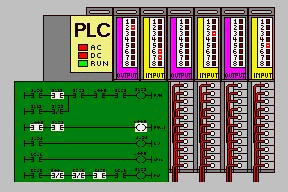 PLC Training Part 4: In the fourth training session your students
will learn proper programming techniques. They will learn how to enter,
edit, add or delete program instruction bits. The scanning sequence
involved in examining the condition of the input field devices,
comparing the program to the condition of the input devices and updating
the output ports is all covered in part 4. Also covered are immediate
update instructions and PLC counter instructions in block format.
PLC Training Part 5: Part 5 continues with PLC programming
instruction bits. Your students will learn how rung format counters
function, block and rung format timer instructions function, latch-
unlatch instructions, math instructions, comparison instructions and
many more pieces of useful information. Our goal is to make your
people understand how each of these instruction bits effect the total
operation of the PLC system.
PLC Training Part 6: In part 6 your students will learn about move
instructions, the binary numbering system, decimal numbering system, how to
count in octal, hexadecimal and BCD digital formats. They will also learn
how to easily convert from one format to another. Since PLC systems are
digital in design, this training is vital.
PLC Training Part 7: Here your students learn how the PLC can be
used to monitor and control a servo valve or servo motor. Part 7 examines
the characteristics of the analog signal and digital signal. It then
progresses into basic open loop and closed loop servo control systems. In
this training segment your students will also learn proper preventative
maintenance procedures for the PLC system, how to read and understand flow
charts, error codes and fault registers. Basic troubleshooting procedures
are also covered in this portion of the PLC training.
PLC Training Part 4: In the fourth training session your students
will learn proper programming techniques. They will learn how to enter,
edit, add or delete program instruction bits. The scanning sequence
involved in examining the condition of the input field devices,
comparing the program to the condition of the input devices and updating
the output ports is all covered in part 4. Also covered are immediate
update instructions and PLC counter instructions in block format.
PLC Training Part 5: Part 5 continues with PLC programming
instruction bits. Your students will learn how rung format counters
function, block and rung format timer instructions function, latch-
unlatch instructions, math instructions, comparison instructions and
many more pieces of useful information. Our goal is to make your
people understand how each of these instruction bits effect the total
operation of the PLC system.
PLC Training Part 6: In part 6 your students will learn about move
instructions, the binary numbering system, decimal numbering system, how to
count in octal, hexadecimal and BCD digital formats. They will also learn
how to easily convert from one format to another. Since PLC systems are
digital in design, this training is vital.
PLC Training Part 7: Here your students learn how the PLC can be
used to monitor and control a servo valve or servo motor. Part 7 examines
the characteristics of the analog signal and digital signal. It then
progresses into basic open loop and closed loop servo control systems. In
this training segment your students will also learn proper preventative
maintenance procedures for the PLC system, how to read and understand flow
charts, error codes and fault registers. Basic troubleshooting procedures
are also covered in this portion of the PLC training.
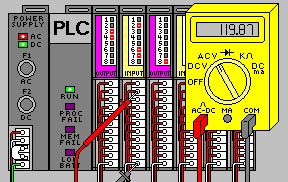 PLC Training Part 8: In the final training session
your students will learn how to systematically localize faults
to either the input, output or logic section of the PLC controller.
They will learn how to troubleshoot with, or without the use
of the program monitor. Part 8 concludes with basic Safety
procedures when working on PLC systems plus an over view of
the material covered in the previous 7 sessions.
Table Of Contents
PLC Training Part 8: In the final training session
your students will learn how to systematically localize faults
to either the input, output or logic section of the PLC controller.
They will learn how to troubleshoot with, or without the use
of the program monitor. Part 8 concludes with basic Safety
procedures when working on PLC systems plus an over view of
the material covered in the previous 7 sessions.
Table Of Contents
Troubleshooting Relay Systems
Retail cost $ 175.00 Your cost $ 155.00
The "RC" training program is a powerful 5-part training course in
troubleshooting Relay Control systems. As with all UCANDO training
products, the information contained in the relay training program is very
practical and can be used on a daily basis. RC-5 contains all materials
necessary to train 5 people. RC-10 contains sufficient material for 10
people. Both training programs contain complete video lessons, workbooks,
pretests, final exams and a leader guide. Suggested training time with
final exam is 20 hours.
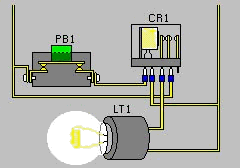 Relay Training Part 1: Day 1 begins with a pretest.
After the pretest, the students examine basic electrical
components like the 3-phase disconnect and circuit breaker.
They will also examine fuse classifications, overload
heaters, control transformers, push button switches, relays
and motors. In the first day they will also learn about
single phasing and reversing 3-phase motor rotation.
Relay Training Part 2: Training session 2 continues with electrical
component operation. In part 2 they will learn about latch relays, lamps,
limit, pressure, flow, thermal, foot, proximity, float, key, rotary,
multi-stage, push-to-test and maintained push button switches. Also covered
in part 2 are timers, timer contacts, solenoids, potentiometers, diodes,
rectifier operation, SCR's, triacs and more.
Relay Training Part 3: During the third training
session your students will examine cable connectors and terminal strips.
After completing basic component operation, the program provides an
introduction to relay circuit
operation. Part 3 concludes with common Safety procedures which should be
followed by all employees or students when working on any electrical system.
Relay Training Part 4: The fourth session provides an in depth understanding
of relay circuit operation. They will learn control fundamentals. The students
will learn the difference between control devices and output devices. They will
learn about relay ladder sequencing and how to wire control transformers for both
high and low 3-phase voltage potentials. At the end of their fourth training
session, your students will be able to read and understand relay ladder diagrams.
Relay Training Part 1: Day 1 begins with a pretest.
After the pretest, the students examine basic electrical
components like the 3-phase disconnect and circuit breaker.
They will also examine fuse classifications, overload
heaters, control transformers, push button switches, relays
and motors. In the first day they will also learn about
single phasing and reversing 3-phase motor rotation.
Relay Training Part 2: Training session 2 continues with electrical
component operation. In part 2 they will learn about latch relays, lamps,
limit, pressure, flow, thermal, foot, proximity, float, key, rotary,
multi-stage, push-to-test and maintained push button switches. Also covered
in part 2 are timers, timer contacts, solenoids, potentiometers, diodes,
rectifier operation, SCR's, triacs and more.
Relay Training Part 3: During the third training
session your students will examine cable connectors and terminal strips.
After completing basic component operation, the program provides an
introduction to relay circuit
operation. Part 3 concludes with common Safety procedures which should be
followed by all employees or students when working on any electrical system.
Relay Training Part 4: The fourth session provides an in depth understanding
of relay circuit operation. They will learn control fundamentals. The students
will learn the difference between control devices and output devices. They will
learn about relay ladder sequencing and how to wire control transformers for both
high and low 3-phase voltage potentials. At the end of their fourth training
session, your students will be able to read and understand relay ladder diagrams.
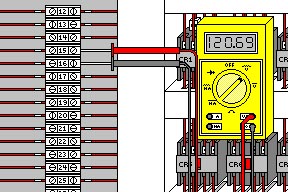 Relay Training Part 5: The final training session
contains useful troubleshooting tips and techniques. Problems
such as locating broken wires, locating shorted components, how
to find the cause of intermittent failures and how to locate
the cause of a blown fuse and many other common electrical
problems are all covered in part 5. The final exam is also
administered in this training session.
Table Of Contents
Relay Training Part 5: The final training session
contains useful troubleshooting tips and techniques. Problems
such as locating broken wires, locating shorted components, how
to find the cause of intermittent failures and how to locate
the cause of a blown fuse and many other common electrical
problems are all covered in part 5. The final exam is also
administered in this training session.
Table Of Contents
Troubleshooting Servo Systems
Retail cost $ 215.00 Your cost $ 186.00
The "SC" training program is an intensive 8-part training course on DC and
AC servo control systems. After completing this fascinating program your
employees, or students will have the knowledge and understanding they need
to competently Troubleshoot and Repair servo drive problems. If you have
CNC or robotic systems operating at your facility, You Need This Training
Program! Suggested training time with final exam is 40 hours. Watch some
of the computer animation on this page and you will see why UCANDO is
changing the way most factories train their maintenance.
Servo Control Training Part 1: Part 1 begins with an introduction into servo control
theory. Your students will examine fundamental operating characteristics of open-loop and close-loop
servo systems. They will also examine basic electrical principles like Ohm's law and power equations,
series circuits and parallel circuits. Part 1 begins laying a solid foundation for mastering servo
control troubleshooting techniques.
Servo Control Training Part 2: In the second portion of this amazing training
course your students will gain an in depth understanding of DC and 3-phase AC motor operation.
Permanent magnet and brushless DC motor operations are covered in great detail. Also covered are
stepper motors and 3-phase squirrel cage motors. Your students will also examine shunt, series,
compound and separately excited DC servo connections. Part 2 also explains the operation of 3-phase
current and how it effects the operation
of both AC and DC motors.
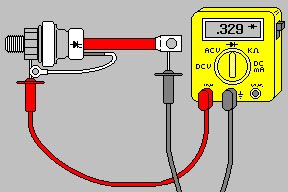 Servo Control Training Part 3: No servo training
is complete without an in depth examination of semiconductor
theory. Part 3 meets this vital need. Your students will take an
exciting journey into semiconductor theory. By the end of th
e day they will understand how semiconductor devices actually
work. They will examine diodes, bi-polar junction transistors,
FET devices, MOSFET devices, SCR's, Triacs and more. Knowing
how to troubleshoot and test these vital components is
necessary for any servo control technician.
Servo Control Training Part 4: This segment of the servo training provides
a close examination of common feedback devices used to monitor both speed and positioning
of a moving axis. They will learn how tach-generators function, resolver operation,
incremental and absolute encoder operation, about inductosyn scales and linear variable
differential transformer (LVDT) operating characteristics. Part 4 also explains how
the main controller is able to monitor and control positioning of an axis. Learning how
feedback devices function is vital to repairing downed equipment due to servo malfunctions.
Servo Control Training Part 3: No servo training
is complete without an in depth examination of semiconductor
theory. Part 3 meets this vital need. Your students will take an
exciting journey into semiconductor theory. By the end of th
e day they will understand how semiconductor devices actually
work. They will examine diodes, bi-polar junction transistors,
FET devices, MOSFET devices, SCR's, Triacs and more. Knowing
how to troubleshoot and test these vital components is
necessary for any servo control technician.
Servo Control Training Part 4: This segment of the servo training provides
a close examination of common feedback devices used to monitor both speed and positioning
of a moving axis. They will learn how tach-generators function, resolver operation,
incremental and absolute encoder operation, about inductosyn scales and linear variable
differential transformer (LVDT) operating characteristics. Part 4 also explains how
the main controller is able to monitor and control positioning of an axis. Learning how
feedback devices function is vital to repairing downed equipment due to servo malfunctions.
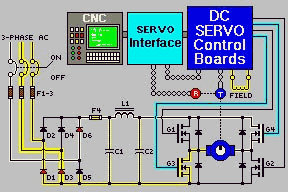 Servo Control Training Part 5: After completing
the first four parts of the servo control training your students
are ready to begin an in depth study of DC control servo systems
and techniques. Phase control, ramp control, PWM and frequency
control techniques are all examined. Also covered in part 5 are
mechanical, dynamic and regenerative braking techniques. Part 5
goes to the heart and soul of the DC servo control system.
Servo Control Training Part 5: After completing
the first four parts of the servo control training your students
are ready to begin an in depth study of DC control servo systems
and techniques. Phase control, ramp control, PWM and frequency
control techniques are all examined. Also covered in part 5 are
mechanical, dynamic and regenerative braking techniques. Part 5
goes to the heart and soul of the DC servo control system.
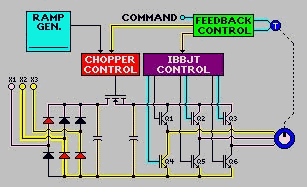 Servo Control Training Part 6: Here your students,
or employees will gain an in depth understanding of AC drive
theory and operation. They will examine voltage source
inverters, voltage variable inverters and current source
inverters. They will also examine phase, ramp, frequency,
pulse width modulation, and chopper control inverter systems.
They will see how the 3-phase electricity is converted into
direct current, filtered and inverted back to a pulsating
potential capable of running an AC motor.
Servo Control Training Part 7: Part 7 continues the study of various servo
drives with the examination of the brushless DC motor drive, stepper motor drive and
vector motor drive. Part 7 also covers system integration, external connections,
avoiding cabling problems, proper enclosures, common electrical problems and proper
grounding techniques.
Servo Control Training Part 8: The final training session is centered around
troubleshooting techniques. They will learn how to analyze servo faults, determine when
drive adjustments are required, how to interpret fault indicators, examine common servo
failures and learn how to handle them. They will also learn Safety procedures when
working around any automated piece of equipment.
Table Of Contents
Servo Control Training Part 6: Here your students,
or employees will gain an in depth understanding of AC drive
theory and operation. They will examine voltage source
inverters, voltage variable inverters and current source
inverters. They will also examine phase, ramp, frequency,
pulse width modulation, and chopper control inverter systems.
They will see how the 3-phase electricity is converted into
direct current, filtered and inverted back to a pulsating
potential capable of running an AC motor.
Servo Control Training Part 7: Part 7 continues the study of various servo
drives with the examination of the brushless DC motor drive, stepper motor drive and
vector motor drive. Part 7 also covers system integration, external connections,
avoiding cabling problems, proper enclosures, common electrical problems and proper
grounding techniques.
Servo Control Training Part 8: The final training session is centered around
troubleshooting techniques. They will learn how to analyze servo faults, determine when
drive adjustments are required, how to interpret fault indicators, examine common servo
failures and learn how to handle them. They will also learn Safety procedures when
working around any automated piece of equipment.
Table Of Contents
Back to UCANDO Main Page
Copyright © 1999-2011, Frank Alexander This page was updated in Dec, 2011



 HYD Training Part 7: Training session 7 begins to apply all the
knowledge your employees, or students have gained in the first 6 training
sessions by illustrating hydraulic prints with the valves shifting position,
cylinders extending and retracting, pressure relief valves operating, flow
controls restricting flow and check valves opening and closing under pressure.
Learning to read a hydraulic print has never been easier.
HYD Training Part 8: The final training session covers basic hydraulic troubleshooting techniques,
fault analysis, common hydraulic system failures and preventative maintenance procedures which can
be implemented to extent the life of almost any piece of hydraulic equipment.
HYD Training Part 7: Training session 7 begins to apply all the
knowledge your employees, or students have gained in the first 6 training
sessions by illustrating hydraulic prints with the valves shifting position,
cylinders extending and retracting, pressure relief valves operating, flow
controls restricting flow and check valves opening and closing under pressure.
Learning to read a hydraulic print has never been easier.
HYD Training Part 8: The final training session covers basic hydraulic troubleshooting techniques,
fault analysis, common hydraulic system failures and preventative maintenance procedures which can
be implemented to extent the life of almost any piece of hydraulic equipment.
 PLC Training Part 1: The PLC training program begins by comparing
the operation of relay circuitry to that of the PLC system. Understanding
these similarities will make learning the PLC system much faster and easier.
The student will learn the sequence of events which must take place in any
automated piece of equipment. They are also introduced to the three
sections of every PLC control system.
PLC Training Part 2: In part 2 of the PLC program your students will be introduced to the operating
principles involved with the input, output and logic sections of the PLC system. Then they will begin their
understanding of basic PLC logic instructions. They will learn about the examine ON, examine OFF and output
instruction bits. Next, they will begin to apply these PLC instruction bits to actual PLC ladder diagrams.
Common addressing techniques are also covered in part 2.
PLC Training Part 3: In the third training session your students will gain an in depth understanding
of the operating principles involved with the input, output and logic sections of the PLC system. Analog,
digital and discrete modules are covered. Part 3 also provides vital information on common power
supply problems.
PLC Training Part 1: The PLC training program begins by comparing
the operation of relay circuitry to that of the PLC system. Understanding
these similarities will make learning the PLC system much faster and easier.
The student will learn the sequence of events which must take place in any
automated piece of equipment. They are also introduced to the three
sections of every PLC control system.
PLC Training Part 2: In part 2 of the PLC program your students will be introduced to the operating
principles involved with the input, output and logic sections of the PLC system. Then they will begin their
understanding of basic PLC logic instructions. They will learn about the examine ON, examine OFF and output
instruction bits. Next, they will begin to apply these PLC instruction bits to actual PLC ladder diagrams.
Common addressing techniques are also covered in part 2.
PLC Training Part 3: In the third training session your students will gain an in depth understanding
of the operating principles involved with the input, output and logic sections of the PLC system. Analog,
digital and discrete modules are covered. Part 3 also provides vital information on common power
supply problems.
 PLC Training Part 4: In the fourth training session your students
will learn proper programming techniques. They will learn how to enter,
edit, add or delete program instruction bits. The scanning sequence
involved in examining the condition of the input field devices,
comparing the program to the condition of the input devices and updating
the output ports is all covered in part 4. Also covered are immediate
update instructions and PLC counter instructions in block format.
PLC Training Part 5: Part 5 continues with PLC programming
instruction bits. Your students will learn how rung format counters
function, block and rung format timer instructions function, latch-
unlatch instructions, math instructions, comparison instructions and
many more pieces of useful information. Our goal is to make your
people understand how each of these instruction bits effect the total
operation of the PLC system.
PLC Training Part 6: In part 6 your students will learn about move
instructions, the binary numbering system, decimal numbering system, how to
count in octal, hexadecimal and BCD digital formats. They will also learn
how to easily convert from one format to another. Since PLC systems are
digital in design, this training is vital.
PLC Training Part 7: Here your students learn how the PLC can be
used to monitor and control a servo valve or servo motor. Part 7 examines
the characteristics of the analog signal and digital signal. It then
progresses into basic open loop and closed loop servo control systems. In
this training segment your students will also learn proper preventative
maintenance procedures for the PLC system, how to read and understand flow
charts, error codes and fault registers. Basic troubleshooting procedures
are also covered in this portion of the PLC training.
PLC Training Part 4: In the fourth training session your students
will learn proper programming techniques. They will learn how to enter,
edit, add or delete program instruction bits. The scanning sequence
involved in examining the condition of the input field devices,
comparing the program to the condition of the input devices and updating
the output ports is all covered in part 4. Also covered are immediate
update instructions and PLC counter instructions in block format.
PLC Training Part 5: Part 5 continues with PLC programming
instruction bits. Your students will learn how rung format counters
function, block and rung format timer instructions function, latch-
unlatch instructions, math instructions, comparison instructions and
many more pieces of useful information. Our goal is to make your
people understand how each of these instruction bits effect the total
operation of the PLC system.
PLC Training Part 6: In part 6 your students will learn about move
instructions, the binary numbering system, decimal numbering system, how to
count in octal, hexadecimal and BCD digital formats. They will also learn
how to easily convert from one format to another. Since PLC systems are
digital in design, this training is vital.
PLC Training Part 7: Here your students learn how the PLC can be
used to monitor and control a servo valve or servo motor. Part 7 examines
the characteristics of the analog signal and digital signal. It then
progresses into basic open loop and closed loop servo control systems. In
this training segment your students will also learn proper preventative
maintenance procedures for the PLC system, how to read and understand flow
charts, error codes and fault registers. Basic troubleshooting procedures
are also covered in this portion of the PLC training.
 PLC Training Part 8: In the final training session
your students will learn how to systematically localize faults
to either the input, output or logic section of the PLC controller.
They will learn how to troubleshoot with, or without the use
of the program monitor. Part 8 concludes with basic Safety
procedures when working on PLC systems plus an over view of
the material covered in the previous 7 sessions.
Table Of Contents
PLC Training Part 8: In the final training session
your students will learn how to systematically localize faults
to either the input, output or logic section of the PLC controller.
They will learn how to troubleshoot with, or without the use
of the program monitor. Part 8 concludes with basic Safety
procedures when working on PLC systems plus an over view of
the material covered in the previous 7 sessions.
Table Of Contents
 Relay Training Part 1: Day 1 begins with a pretest.
After the pretest, the students examine basic electrical
components like the 3-phase disconnect and circuit breaker.
They will also examine fuse classifications, overload
heaters, control transformers, push button switches, relays
and motors. In the first day they will also learn about
single phasing and reversing 3-phase motor rotation.
Relay Training Part 2: Training session 2 continues with electrical
component operation. In part 2 they will learn about latch relays, lamps,
limit, pressure, flow, thermal, foot, proximity, float, key, rotary,
multi-stage, push-to-test and maintained push button switches. Also covered
in part 2 are timers, timer contacts, solenoids, potentiometers, diodes,
rectifier operation, SCR's, triacs and more.
Relay Training Part 3: During the third training
session your students will examine cable connectors and terminal strips.
After completing basic component operation, the program provides an
introduction to relay circuit
operation. Part 3 concludes with common Safety procedures which should be
followed by all employees or students when working on any electrical system.
Relay Training Part 4: The fourth session provides an in depth understanding
of relay circuit operation. They will learn control fundamentals. The students
will learn the difference between control devices and output devices. They will
learn about relay ladder sequencing and how to wire control transformers for both
high and low 3-phase voltage potentials. At the end of their fourth training
session, your students will be able to read and understand relay ladder diagrams.
Relay Training Part 1: Day 1 begins with a pretest.
After the pretest, the students examine basic electrical
components like the 3-phase disconnect and circuit breaker.
They will also examine fuse classifications, overload
heaters, control transformers, push button switches, relays
and motors. In the first day they will also learn about
single phasing and reversing 3-phase motor rotation.
Relay Training Part 2: Training session 2 continues with electrical
component operation. In part 2 they will learn about latch relays, lamps,
limit, pressure, flow, thermal, foot, proximity, float, key, rotary,
multi-stage, push-to-test and maintained push button switches. Also covered
in part 2 are timers, timer contacts, solenoids, potentiometers, diodes,
rectifier operation, SCR's, triacs and more.
Relay Training Part 3: During the third training
session your students will examine cable connectors and terminal strips.
After completing basic component operation, the program provides an
introduction to relay circuit
operation. Part 3 concludes with common Safety procedures which should be
followed by all employees or students when working on any electrical system.
Relay Training Part 4: The fourth session provides an in depth understanding
of relay circuit operation. They will learn control fundamentals. The students
will learn the difference between control devices and output devices. They will
learn about relay ladder sequencing and how to wire control transformers for both
high and low 3-phase voltage potentials. At the end of their fourth training
session, your students will be able to read and understand relay ladder diagrams.
 Relay Training Part 5: The final training session
contains useful troubleshooting tips and techniques. Problems
such as locating broken wires, locating shorted components, how
to find the cause of intermittent failures and how to locate
the cause of a blown fuse and many other common electrical
problems are all covered in part 5. The final exam is also
administered in this training session.
Table Of Contents
Relay Training Part 5: The final training session
contains useful troubleshooting tips and techniques. Problems
such as locating broken wires, locating shorted components, how
to find the cause of intermittent failures and how to locate
the cause of a blown fuse and many other common electrical
problems are all covered in part 5. The final exam is also
administered in this training session.
Table Of Contents
 Servo Control Training Part 3: No servo training
is complete without an in depth examination of semiconductor
theory. Part 3 meets this vital need. Your students will take an
exciting journey into semiconductor theory. By the end of th
e day they will understand how semiconductor devices actually
work. They will examine diodes, bi-polar junction transistors,
FET devices, MOSFET devices, SCR's, Triacs and more. Knowing
how to troubleshoot and test these vital components is
necessary for any servo control technician.
Servo Control Training Part 4: This segment of the servo training provides
a close examination of common feedback devices used to monitor both speed and positioning
of a moving axis. They will learn how tach-generators function, resolver operation,
incremental and absolute encoder operation, about inductosyn scales and linear variable
differential transformer (LVDT) operating characteristics. Part 4 also explains how
the main controller is able to monitor and control positioning of an axis. Learning how
feedback devices function is vital to repairing downed equipment due to servo malfunctions.
Servo Control Training Part 3: No servo training
is complete without an in depth examination of semiconductor
theory. Part 3 meets this vital need. Your students will take an
exciting journey into semiconductor theory. By the end of th
e day they will understand how semiconductor devices actually
work. They will examine diodes, bi-polar junction transistors,
FET devices, MOSFET devices, SCR's, Triacs and more. Knowing
how to troubleshoot and test these vital components is
necessary for any servo control technician.
Servo Control Training Part 4: This segment of the servo training provides
a close examination of common feedback devices used to monitor both speed and positioning
of a moving axis. They will learn how tach-generators function, resolver operation,
incremental and absolute encoder operation, about inductosyn scales and linear variable
differential transformer (LVDT) operating characteristics. Part 4 also explains how
the main controller is able to monitor and control positioning of an axis. Learning how
feedback devices function is vital to repairing downed equipment due to servo malfunctions.
 Servo Control Training Part 5: After completing
the first four parts of the servo control training your students
are ready to begin an in depth study of DC control servo systems
and techniques. Phase control, ramp control, PWM and frequency
control techniques are all examined. Also covered in part 5 are
mechanical, dynamic and regenerative braking techniques. Part 5
goes to the heart and soul of the DC servo control system.
Servo Control Training Part 5: After completing
the first four parts of the servo control training your students
are ready to begin an in depth study of DC control servo systems
and techniques. Phase control, ramp control, PWM and frequency
control techniques are all examined. Also covered in part 5 are
mechanical, dynamic and regenerative braking techniques. Part 5
goes to the heart and soul of the DC servo control system.
 Servo Control Training Part 6: Here your students,
or employees will gain an in depth understanding of AC drive
theory and operation. They will examine voltage source
inverters, voltage variable inverters and current source
inverters. They will also examine phase, ramp, frequency,
pulse width modulation, and chopper control inverter systems.
They will see how the 3-phase electricity is converted into
direct current, filtered and inverted back to a pulsating
potential capable of running an AC motor.
Servo Control Training Part 7: Part 7 continues the study of various servo
drives with the examination of the brushless DC motor drive, stepper motor drive and
vector motor drive. Part 7 also covers system integration, external connections,
avoiding cabling problems, proper enclosures, common electrical problems and proper
grounding techniques.
Servo Control Training Part 8: The final training session is centered around
troubleshooting techniques. They will learn how to analyze servo faults, determine when
drive adjustments are required, how to interpret fault indicators, examine common servo
failures and learn how to handle them. They will also learn Safety procedures when
working around any automated piece of equipment.
Table Of Contents
Servo Control Training Part 6: Here your students,
or employees will gain an in depth understanding of AC drive
theory and operation. They will examine voltage source
inverters, voltage variable inverters and current source
inverters. They will also examine phase, ramp, frequency,
pulse width modulation, and chopper control inverter systems.
They will see how the 3-phase electricity is converted into
direct current, filtered and inverted back to a pulsating
potential capable of running an AC motor.
Servo Control Training Part 7: Part 7 continues the study of various servo
drives with the examination of the brushless DC motor drive, stepper motor drive and
vector motor drive. Part 7 also covers system integration, external connections,
avoiding cabling problems, proper enclosures, common electrical problems and proper
grounding techniques.
Servo Control Training Part 8: The final training session is centered around
troubleshooting techniques. They will learn how to analyze servo faults, determine when
drive adjustments are required, how to interpret fault indicators, examine common servo
failures and learn how to handle them. They will also learn Safety procedures when
working around any automated piece of equipment.
Table Of Contents